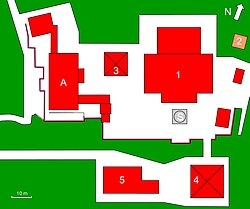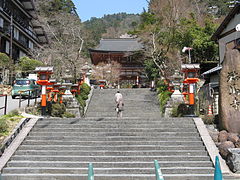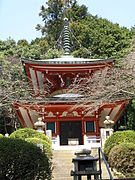Kurama-dera
The Kurama-dera ( Japanese 鞍馬 寺 ) with the mountain name Kurama-yama (鞍馬 山) is a temple that belonged to the Tendai direction of Buddhism until 1949 , but has since been the main temple of its own Buddhist denomination. The temple is located on the southern slope halfway up the 570 m high Kuramayama in the north of Kyoto.
history
According to the temple tradition "Ambagaiji engi" (鞍馬 蓋 寺 縁 起), the temple was laid out in 770 by a disciple of the priest Kanjin (鑑真), namely Kantei (鑑 禎), as a place of prayer, namely to worship St. Bishamon (毘 沙門 天) that he had made himself. 796 the abbot of the temple ZOTO-ji (造東寺), Fujiwara no Isendo (藤原伊勢人, 759-827), the Bishamon Hall to a temple to worship the holy according to the "Fuso ryakuki" (扶桑略記) Kannon converted to have.
During the Heian period , during the Kambyō reign (889-898), Jūzenji Buen (十 禅師 峯 延) was appointed by the Tō-ji to the Kurama-ji's bettō . He put the temple grounds back in order. During this time the chief of the Tendai doctrine , Chūjin (忠 尋, 1065–1138) visited the temple and was able to move him to accept the Shingon doctrine of Buddhism.
From 1919, the only 25-year-old Shigaraki Shinjun (信 楽 真 純) started the temple again, which had suffered badly from fires and the violent separation of Shintoism and Buddhism (廃 仏 希 釈, Haibutsu kishaku) at the beginning of the Meiji period to prepare. In 1945 the main hall and other buildings burned down again. The old strength of the temple had been exhausted under these circumstances. In 1947 a new interpretation of Buddhism was developed at the temple under the name "Wide Teaching on Kurama" (鞍馬 弘 教, Kurama kōkyō), and two years later they went into business for themselves.
The attachment
From the mountain station of the Eizan Railway (叡 山 電 鉄 鞍馬 駅, Eizan dentetsu Kuram-eki) straight on, you have the temple gate (山門, Sammon) on your left , which is here as a Niō gate (仁王 門), i.e. as a gate the two temple guards to the right and left of the passage. In this case, the gate is designed as a magnificent tower gate . After the gate burned down in 1881, it was not rebuilt until twenty years later, in 1911. The two temple guards are said to come from Unkei's eldest son, Tankei . They were transferred here from Tamba Province at the time of the reconstruction . From the Niō Gate to the Middle Gate (中 門, Chūmon) there is a multi-winding forest path up, which is why it is called the “Ninety-nine Winding Pilgrimage Path” (九十 九折 参 道, Tsuzura-ori sandō).
The main hall (本 殿, Honden, in Plan 1) is on the highest level of the temple, which is surrounded by a retaining wall . The current one was built in 1971 from reinforced concrete. There a ten-armed Kannon-bosatsu (千手 観 音), a Bishamon-ten and Gohōma-ōson (護法 魔王 尊) are worshiped together as the moon, sun and earth. They are made as a connected trinity (三 身 一体 尊, Sanjin ittai-son). In front of the main hall you can see a circular elevation, the Shōundai (翔雲 台; S), for whose stone slabs the cover plates (板 石, Itaishi) of a sutr chamber (経 塚, Kyōzuka) excavated behind the main hall were used.
To the right of the main hall is the Akaigohōzen shrine (閼 伽 井 護法 善 神社; 2). It venerates Akaigohōzen, who used the water from Mount Kurama to heal priest Buen when he was bitten by a large snake. To the left of the main hall is the Kōmyōshin-den (光明 心 殿; 3) with a pyramid roof in which the Goma (護 摩) ceremony is performed. Further left you come to the abbot's quarters (A), the main building of which is called Kongōjumei-in (金剛 寿命 院).
On one level below is the hall called Temporin-dō (転 法輪 堂; 4) and the guest quarters (寝殿, Shinden; 5).
Temple treasures
If you leave the upper temple area to the west and cross a street, you come to the treasury of the temple, the Kuramasan Reihōden (鞍馬 山 霊 宝殿). The ground floor serves as a natural history museum, in which rocks, mushrooms, insects, shells and plants are shown. The 1st floor houses a treasury. You can see a bronze lantern (銅 灯 篭, Dōdōrō), according to the inscription from the Shōka era (正 嘉, 1257–1259). It, registered as an important cultural asset of Japan , once stood in front of the main hall. A treasure pagoda made of stone, a sutras container (経 筒, Kyōzutsu) from 1120, a fragment of a container made of gilded bronze plates for a saint (金 銅板 押出 菩薩 像 残 闕, Kondōban oshidashi Bosatsuzō zanketsu) and other objects from the Heian-bis in Kamakura period are registered as the national treasures of Japan .
The 2nd floor houses Buddhist sculptures. There you can see the group of sculptures that once stood in the main hall. It is made of wood and shows Bishamon-ten together with Kisshō-ten and Zennishi-dōshi (毘 沙門 天 及 吉祥 天 善 膩 師 童子立 像, Mokuzō Bishamonten oyobi Kisshō-ten Zennishi-dōshi ritsuzō). The group dates from the Heian period and is registered as a national treasure. As a special feature, the great Bishamon holds a trident (三叉戟. Sansageki) in his right hand and raises the left as if he wanted to look into the distance. The figure is called "Reich Protector" (鎮 護 国家, Chingo Kokka). Other sculptures include a Bishamon as patron god (木造 毘 沙門 天 立 像 鎮守 夜叉, Mokuzō Bishamon-ten ritsuzō Shinjuzasha) from the Heian period and a Kannon figure (木造 観 音 菩薩 立 像, Mokuzō Kannon bosatsu ritsuzō) from the year 1226. Both are registered as an important cultural asset.
There is a memorial stone for Yosano Tekkan and Akiko next to the treasure house . On the front there are the characters "Tōhaku-tei" (冬 柏 亭): that was the name Akiko's writing pavilion. The stone was erected by her students in front of her pavilion on the occasion of Akiko's 50th birthday in 1929 and moved here in 1976.
photos
Remarks
- ↑ The name of the hall is derived from turning the wheel of the Buddha's teaching.
literature
- Kyoto-fu rekishi isan kenkyukai (Ed.): Kurama-dera . In: Kyoto-fu no rekishi sampo (chu). Yamakawa Shuppan, 2011. ISBN 978-4-634-24726-0 .
Web links
Coordinates: 35 ° 7 '5 " N , 135 ° 46' 14.7" E







